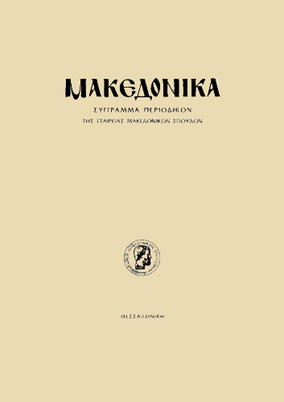Ανασκαφή μεσοβυζαντινού ναού στο Σισάνι Κοζάνης : νέα στοιχεία για την επισκοπή Σισανίου
Part of : Μακεδονικά ; Vol.32, 2000, pages 313-337
Issue:
Pages:
313-337
Parallel Title:
Excavation of a Middle Byzantine Church at Sisani near Kozani : New Information on the Diocese of Sisanion.
Section Title:
Articles
Author:
Abstract:
The church examined in this' article is built on the ruins of an earlier building (5th-6th cent.) and, despite its fragmentary state of preservation, in plan it consists of a cross-in-square structure set within a long rectangular three-aisled basilica. It contains archaic features in the form of the semi circular built synthronon which was uncovered in the sanctuary and the typo logy of the bipartite parabemata. The mural decoration which survives in the sanctuary and the prothesis, as well as a series of small glazed tiles with engraved representations, can be attributed to the time of the church’s foundation. On the basis of the typology of the church, the construction technique, the surviving mural decoration, the pottery discovered in the fill, the glazed clay tiles and numerous fragments of wall-paintings, the structure must date to the 12th century, or even the 11th. The church was destroyed by a violent natural cause, probably an earth quake, in the first half of the 13th century at the latest, and the remains were reused to create a cross-in-square church on the site of the old basilica, although there is no firm evidence for the existence of a dome. Notable fea tures from this period are the opus sectile marble flooring in front of the sanctuary and the new extensive wall-paintings in the naos and the narthex. On the evidence of the bold traces of fire on the floor of the church, another disaster must have taken place at some time before the beginning of the 15th century. The Byzantine name of the church that has been uncovered remains unknown. However, a representation on the narrow west side of the south pier of the sanctuary, which depicts the founder-bishop kneeling before the Virgin enthroned, shows that it was an episcopal church and dedicated to the Pana- ghia. Given the fact that the church lies immediately next to the present-day Monastery of the Panaghia, it would be reasonable to assume that it con stitutes the original church of the latter. The value of the new find lies in its rare architectural type, its mural decoration, and the fact that it marks the existence of Byzantine Sisanioupolis (?), which was very probably built between the old monasteries of St. De metrius and the Panaghia.
Subject (LC):
Notes:
856:https://ejournals.epublishing.ekt.gr/index.php/makedonika/article/view/5735, DOI: https://doi.org/10.12681/makedonika.174
Electronic Resources:




